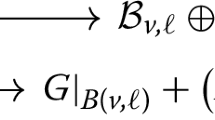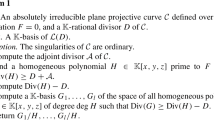Abstract
Some deterministic and probabilistic methods are presented for counting and estimating the number of points on curves over finite fields, and on their projections. The classical question of estimating the size of the image of a univariate polynomial is a special case. For curves given by sparse polynomials, the counting problem is #P-complete via probabilistic parsimonious Turing reductions.
Similar content being viewed by others
References
W. R. Alford, A. Granville, andC. Pomerance, There are infinitely many Carmichael numbers.Annals of Mathematics 140 (1994), 703–722.
E. Bach, Weil bounds for singular curves.Applicable algebra in Engineering, Communication and Computing 7 (1996), 289–298.
J. Birch andH. P. F. Swinnerton-Dyer, Note on a problem of Chowla.Acta Arith. 5 (1959), 417–423.
E. Bombieri, On exponential sums in finite fields.Amer. J. Math. 88 (1966), 71–105.
A. L. Chistov and D. Yu. Grigoryev, Polynomial-time factoring of the multivariable polynomials over a global field. LOMI preprint E-5-82, Leningrad, USSR, 1982.
M. Clausen, A. Dress, J. Grabmeier, andM. Karpinski, On zero testing and interpolation ofk-sparse multivariate polynomials over finite fields.Theor. Computer Science 84 (1991), 151–164.
D. Coppersmith andS. Winograd, Matrix multiplication via arithmetic progressions.J. Symb. Comp. 9 (1990), 251–280.II. Davenport,Multiplicative Number Theory. Springer-Verlag, Second edition, 1980.
A. Díaz and E. Kaltofen, On computing greatest common divisors with polynomials given by black boxes for their evaluations. InProc. ISSAC 1995, 1995.
M. D. Fried and M. Jarden,Field Arithmetic. Springer-Verlag, 1986.
M. R. Garey andD. S. Johnson,Computers and intractability: A guide to the theory of NP-Completeness. W. H. Freeman, San Francisco CA, 1979.
J. Von zur Gathen, Tests for permutation polynomials.SIAM J. Comput. 20(3) (1991), 591–602.
J. von zur Gathen andE. Kaltofen, Factorization of multivariate polynomials over finite fields.Math. Comp. 45 (1985), 251–261.
J. von zur Gathen andV. Shoup, Computing Frobenius maps and factoring polynomials.Computational complexity 2 (1992), 187–224.
J. von zur Gathen and I. E. Shparlinski, Components and projections of curves over finite fields. InProc. 5th Int. Symp. on Algorithms and Computation ISSAC '94, vol. 834 ofSpringer Lecture Notes in Computer Science, 1994, 297–305. SIAM J. Comput., to appear.
J. von zur Gathen and I. E. Shparlinski, Finding points on curves over finite fields. InProc. 36th Ann. IEEE Symp on Foundations of Computer Science, 1995, 284–292.
D. Yu. Grigoryev and M. Karpinski, An approximation algorithm for the number of zeros of arbitrary polynomials overGF(q). InProc. 20th Ann. IEEE Symp. Foundations of Computer Science, 1991, 662–669.
D. Yu. Grigoryev, M. Karpinski, andM. F. Singer, Fast parallel algorithms for sparse multivariate polynomial interpolation over finite fields.SIAM J. Comp. 19 (1990), 1059–1063.
R. Hartshorne,Algebraic Geometry. Springer-Verlag, 1977.
M.-D. Huang and D. Ierardi, Counting rational points on curves over finite fields. InProc. 34th Ann. IEEE Symp. on Foundations of Computer Science, Palo Alto CA, 1993, 616–625.
E. Kaltofen, Fast parallel absolute irreducibility testing.J. Symb. Computation 1 (1985), 57–67.
R. M. Karp, M. Luby, andN. Madras, Monte-Carlo approximation algorithms for enumeration problems.J. Algorithms 10(3) (1989), 429–448.
M. Karpinski andM. Luby, Approximating the number of solutions of aGF[2] polynomial.J. Algorithms 14 (1993), 280–287.
A. K. Lenstra, Factoring multivariate polynomials over finite fields.J. Comput. System Sci. 30 (1985), 235–248.
R. Lidl andH. Niederreiter,Finite Fields, vol. 20 ofEncyclopedia of Mathematics and its Applications. Addison-Wesley, Reading MA, 1983.
K. Ma andJ. von zur Gathen, Tests for permutation functions.Finite Fields and their Applications 1 (1995), 31–56.
K. S. McCurley, Explicit zero-free regions for DirichletL-functions.J. Number Theory 19 (1984), 7–32.
R. Pila, Frobenius maps of Abelian varieties and finding roots of unity in finite fields.Math. Comp. 55 (1990), 745–763.
D. A. Plaisted, Sparse complex polynomials and polynomial reducibility.J. Comp. and System Sciences 14 (1977), 210–221.
D. A. Plaisted, New NP-hard and NP-complete polynomial and integer divisibility problems.Theor. Computer Science 31 (1984), 125–138.
A. Quick, Some GCD and divisibility problems for sparse polynomials. Technical Report 191/86, Department of Computer Science, University of Toronto, 1986.
J. B. Rosser andL. Schoenfeld, Approximate formulas for some functions of prime numbers.Ill. J. Math. 6 (1962), 64–94.
R. J. Schoof, Elliptic curves over finite fields and the computation of square roots modp.Math. Comp. 44(170) (1985), 483–494.
J. T. Schwartz, Fast probabilistic algorithms for verification of polynomial identities.J. Assoc. Computing Machinery 27 (1980), 701–717.
J.-P. Serre, Sur le nombre des points rationels d'une courbe algébrique sur un corps fini.C.R. Acad. Sci. Paris, Ser. 1 296 (1983a), 397–402.
J.-P. Serre, Nombre de points des courbes algébriques sur F q .Sémin. de Théorie des Nombres de Bordeaux (1983b), 1–8.
I. R. Shafarevich,Basic algebraic geometry. Grundlehren Band 213. Springer Verlag, 1974.
V. Shoup, Searching for primitive roots in finite fields.Math. Comp. 58(197) (1992), 369–380.
I. E. Shparlinski, On primitive elements in finite fields and on elliptic curves.Mat. Sbornik 181(9) (1990), 1196–1206. Math. USSR Sbornik71 (1992), 41–50.
I. E. Shparlinski,Computational and algorithmic problems in finite fields, vol. 88 ofMathematics and its applications. Kluwer Academic Publishers, 1992a.
I. E. Shparlinski, A deterministic test for permutation polynomials.Computational complexity 2 (1992b), 129–132.
I. E. Shparlinski andA. N. Skorobogatov, Exponential sums and rational points on complete intersections.Mathematika 37 (1990), 201–208.
I. M. Vinogradov,Elements of number theory. Dover Publ. New York NY, 1954.
S. G. Vladut andV. G. Drinfeld, Number of points on an algebraic curve.Funktsional'nyi Analis i Prilogenija 17(1) (1983), 68–69. Functional Analysis and its Appl.17 (1983), 53–54.
Author information
Authors and Affiliations
Rights and permissions
About this article
Cite this article
von zur Gathen, J., Karpinski, M. & Shparlinski, I. Counting curves and their projections. Comput Complexity 6, 64–99 (1996). https://doi.org/10.1007/BF01202042
Received:
Issue Date:
DOI: https://doi.org/10.1007/BF01202042




